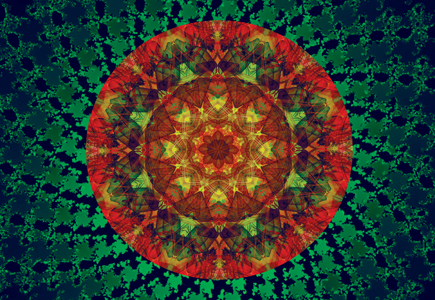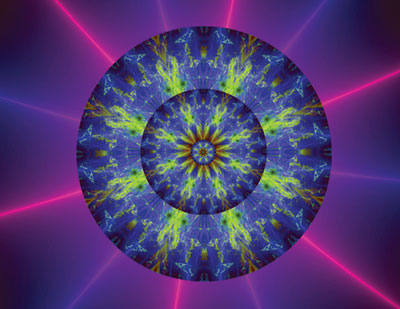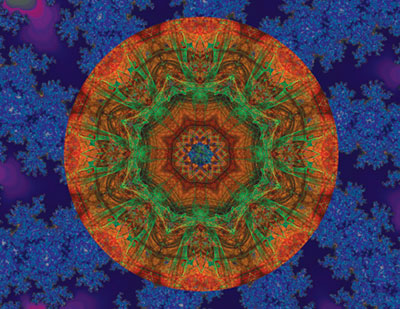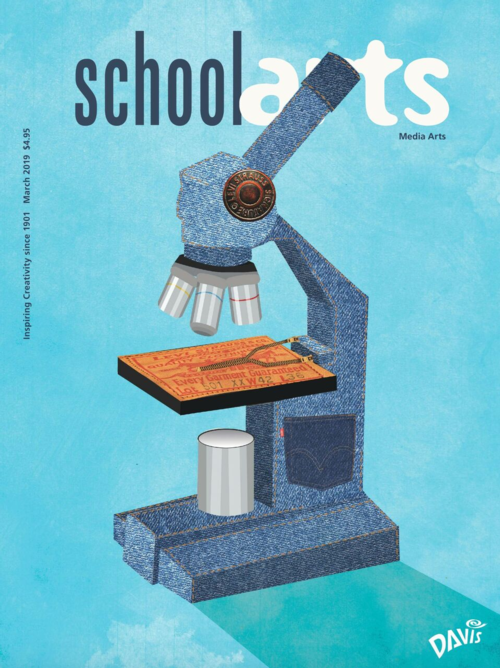 Katie Heiden, grade seven.
Katie Heiden, grade seven.
As a graphic arts teacher at the middle-school level for twelve years, I’ve developed various lessons that employ crosscurricular concepts that allow students to gain better insight into the creation process. Fractals are an exciting way to introduce math and science into the curriculum while captivating students’ interests as they create their digital artworks.
Mandelbrot and the Fractal
When I first introduced my fractal lesson, students became aware that, for centuries, the brightest minds have struggled to unlock the mysteries hidden within a fractal. Benoit Mandelbrot was the first scientist to graph a fractal set using IBM computers to calculate complex mathematical equations. Mandelbrot’s exploration with new technology connects with my own passion to utilize the latest technology to create my own artwork and improve my graphics arts curriculum.
Engaging Examples
After providing students with a historical context, I emphasized the visual nature of fractals through plenty of engaging examples. Koch’s snowflake demonstrates the fundamental concepts of fractals both visually and mathematically. Artist Katsushika Hokusai’s portrayal of nature reinforces repetition and pattern through the use of fractals in many of his woodblock prints. The splatter of an abstract expressionist painting by Jackson Pollock illustrates the concept of self-similarity, a basic property of fractals. The more students understand the essence of fractals, the more motivated they become to create mesmerizing fractal artworks.
 Derek Lucier, grade seven.
Derek Lucier, grade seven.
Moving to the Computer
Students designed their fractal mandala artwork on the computer. Before they began, I researched and downloaded fractal generators that are user-friendly and produce a variety of fractal designs. Students used these generators to create fractals to use in their final mandala designs. I also required students to save their images at a high-resolution so the artwork wouldn’t become pixelated when printed.
Once students designed a plethora of different fractal images, they began placing and blending their fractal images onto a pie-shaped piece on a mandala template I designed in Photoshop. Along with the template, students also followed my step-by-step tutorial and in-class instruction to guide them through the design process.
Once students completed the pie in Photoshop, they placed another fractal image in the background that contrasted with the pie-shaped fractal in the foreground. I encouraged students to lighten the pie and bring out the color saturation in to make the pie pop out from the background.
 Francesca Mathews, grade seven.
Francesca Mathews, grade seven.
Challenges
As students applied their skills, there were steps in the tutorial they found challenging. As a result, I tweaked my tutorial to provide clearer and more efficient instruction. I added complete Photoshop screenshots with the keyboard shortcuts, demonstrating how to complete the task. I observed many students who struggled to line up the pie pieces so the center of the pie cleanly fit together. To resolve this issue, I had these students duplicate the completed pie and shrink down the pie copy to the middle so the center of the pie looked more aligned. This optional step was added to the tutorial.
Reflections
Creating artwork with fractals promotes many facets of cross-curriculum learning. With the excitement surrounding STEAM initiatives and the possibility of collaboration with the science and math department, incorporating fractals into your art curriculum can also help you discover a whole new world of learning. Fractals in art are an engaging way for art, science, and math to coexist in harmony while your students produce artwork that is extremely unique and inspiring.
Kevin Fogelson is a graphic arts teacher at Antioch Upper Grade School in Hainesville, Illinois. fogelks@gmail.com
NATIONAL STANDARD
Presenting: Develop and refine artistic techniques and work for presentation.
View this article in the digital edition.


 Katie Heiden, grade seven.
Katie Heiden, grade seven. Derek Lucier, grade seven.
Derek Lucier, grade seven.  Francesca Mathews, grade seven.
Francesca Mathews, grade seven. 